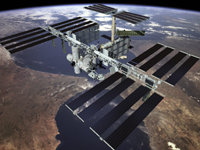
Home
Rocketry
Orbits
Technology
CEV
ISS
X-Prize
Virgin Galactic
RTG
Ion Propulsion
The International Space Station

The International Space Station (ISS) is a joint project between five space organizations, which are: the National Aeronautics and Space Administration (United States), the Russian Federal Space Agency (Russia), the Canadian Space Agency (Canada), the European Space Agency (Europe) and the Japan Aerospace Exploration Agency(Japan).
The ISS orbits the Earth in a circular orbit at approximately 360 km altitude. The period of ISS orbiting the Earth is about 91.61 minutes. Since the launch of the first component, Zarya module was back on Nov 20, 1998, it had completed more than 37,500 orbits by June 2005.

In many aspects, the ISS behaves as a consolidation of severally previous developed independent space stations, such as Russia’s MIR, European Columbus, United States’ Space Station Freedom and Japanese Experiment Module. Currently, ISS is still under construction and it has become a permanent sign of the human presence in space. Since Nov 2, 2005 it retains at least a crew of 2 all the time.
Primarily, the transportation between ISS and the ground is served by Soyuz, Progress spacecraft units and Space Shuttle. The ISS is expected to be complete around 2010. Above is a computer model of the completed ISS.